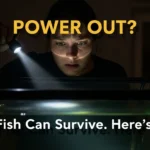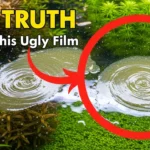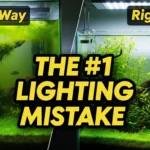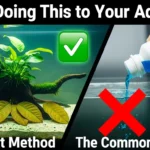It should be the easiest question in the entire hobby, yet it’s the one that causes the most confusion and anxiety for beginners. You have your new tank, you have your plants, and now you’re staring at a wall of aquarium lights, completely lost. You’re probably wondering, how much light do aquarium plants need to thrive without turning your beautiful new tank into a swampy, green mess?
If you’ve looked for an answer, you’ve likely found a confusing mess of outdated rules, scientific jargon, and heated debates. People will tell you about “watts per gallon,” “lumens,” “PAR,” and “spectrum,” and it’s enough to make you want to give up before you’ve even started.
Let’s stop right there. Forget all of that for a moment.
As someone who has navigated this exact confusion and helped countless beginners find their footing, I’m going to give you the simple, practical guide I wish I had. We’re going to skip the complicated math and focus on a simple framework that will give you the confidence to choose the right light and, more importantly, use it correctly to grow lush, healthy plants and keep algae at bay.
The Only 3 Levels of Light You Need to Know
In the world of planted tanks, we can simplify all the complex measurements down to three basic levels: Low, Medium, and High. For a beginner starting a low-tech tank, understanding these categories is the key to success.
- Low Light: This is the “safe zone” and the sweet spot for almost all low-tech tanks. It’s enough energy for a huge variety of beautiful, hardy plants to grow well, but it’s not enough energy to fuel explosive algae outbreaks.
- Medium Light: This is the “enthusiast zone.” It opens up the possibility for growing more demanding plants, like some carpeting species, but it requires a more careful balance of nutrients and carries a higher risk of algae if that balance is off.
- High Light: This is the “expert zone.” High light is reserved for high-tech tanks that are also supplied with injected CO2 and a heavy, consistent stream of fertilizers. Using a high-light fixture on a low-tech tank is the fastest way to create a massive algae farm. For a beginner, high light should be avoided at all costs.
So, for our purposes, we are focusing entirely on achieving that perfect “low light” sweet spot.
How Many Hours a Day Should the Light Be On?
This is the most common question, and here is your direct answer:
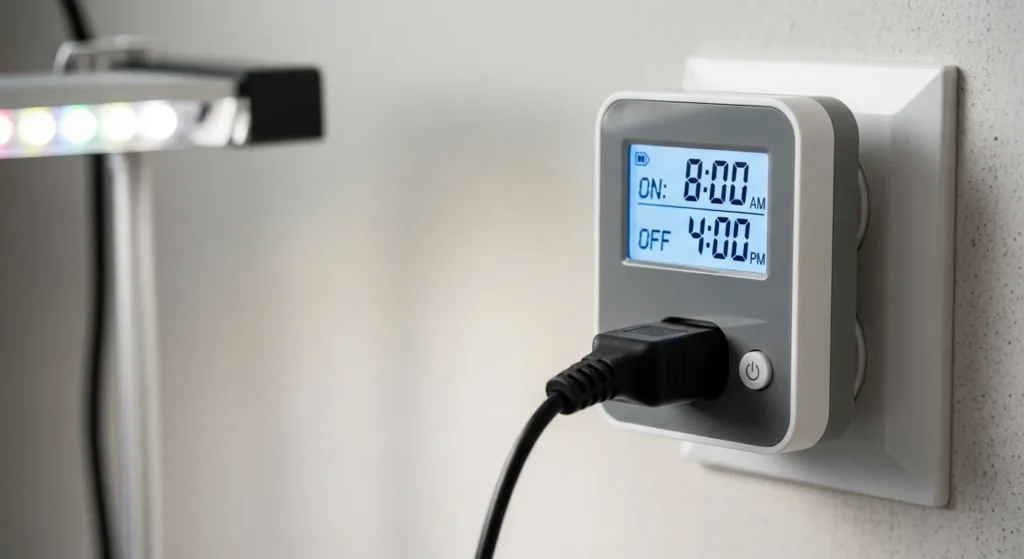
For a beginner low-tech planted tank, your light should be on for 6 to 8 hours per day. No more.
This is the single most important rule. The duration your light is on is called the “photoperiod.” An 8-hour photoperiod gives your plants plenty of time to photosynthesize and grow, but it’s not so long that it provides a huge window of opportunity for algae. The easiest way to guarantee this consistency is to plug your light into a simple, cheap outlet timer. Set it and forget it. This consistency is a cornerstone of effective aquarium algae control.
How to Choose the Right Light Fixture (Without a Science Degree)
This is where people get intimidated by the technology. Let’s make it simple. The old “watts-per-gallon” rule is completely useless for modern LED lights. Instead of worrying about numbers, focus on these three practical features.
- Choose an LED Designed for Plant Growth: When you’re shopping, ignore the cheap, simple lights that come in basic aquarium kits. Those are often designed just to make fish visible. You want a light that specifically says it’s for “live plants.” These fixtures will have a fuller spectrum of light that includes the red and blue wavelengths that plants need for healthy growth.
- Look for Adjustable Brightness (A Game-Changer): Many modern, budget-friendly plant LEDs come with a dimmer or adjustable brightness settings. This is an incredibly powerful feature. It allows you to buy a slightly stronger light and simply dim it down to that perfect “low light” level. It gives you control and the ability to make small adjustments, which is far better than having a light that is only “on” or “off.”
- Ensure It Fits Your Tank’s Length: This sounds obvious, but it’s important. You want a light that provides even coverage from one end of your tank to the other. A light that’s too short will create dark corners where plants will struggle.
How Much Light Do Aquarium Plants Need? A Practical Framework
Okay, so how do you put this all together? How do you know if the light you have is truly in that “low light” sweet spot? We can use a simple, observational method.
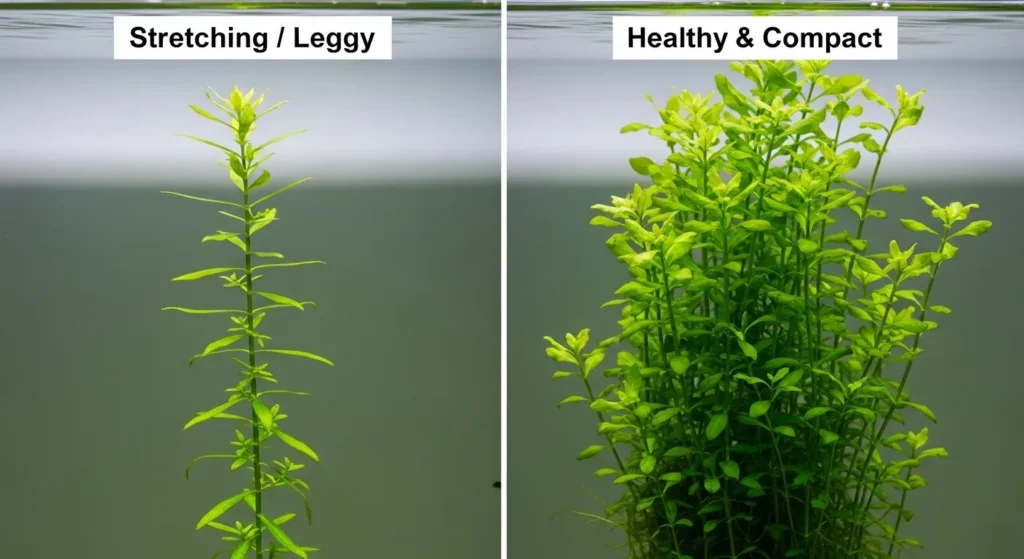
- If your plants are growing slowly but look healthy and green, and you have little to no algae, you have successfully achieved the perfect low-light balance. This is the goal.
- If your plants are “stretching” or “leggy” (growing very tall and thin with lots of space between leaves), and look pale, they may not be getting enough light. You can try increasing the brightness slightly or moving the light closer to the water.
- If you are constantly battling green, fuzzy, or stringy algae, your light is almost certainly too bright or is on for too long. This is your tank’s way of screaming for help. Your first and most important action should be to reduce the brightness or shorten the photoperiod to 6 hours.
This observational approach is far more valuable than any PAR meter for a beginner. Your tank will tell you everything you need to know; you just have to learn how to listen.
The Role of Tank Shape and Depth
It’s important to remember that the shape of your aquarium plays a huge role in lighting. As we discussed in our guide to choosing the perfect aquarium, a “long” tank is much better than a “tall” tank.
Light intensity drops off dramatically as it travels through water. In a tall tank, the light has to penetrate a much deeper column of water to reach the substrate. This means that a light that provides perfect “low light” at the top of a tall tank might provide almost no usable light at the bottom. A shallower, “long” style tank ensures that your light can be distributed much more evenly to all of your plants.
Do Different Plants Need Different Amounts of Light?
Yes, absolutely. This is where the concept of “plant selection” becomes so important in a low-tech tank. We are choosing plants that thrive in our chosen “low light” environment.
- True Low-Light Plants: These are the superstars of a low-tech tank. They have adapted to grow in shady conditions and do not need intense light. This category includes classics like Anubias, Java Fern, Bucephalandra, and most Cryptocorynes.
- Medium-Light Plants: These plants can often survive in a low-light tank, but they might not grow as fast or look as vibrant. This includes many common stem plants.
- High-Light Plants: These are plants that absolutely require intense light and, almost always, supplemental CO2 to survive. This includes most of the delicate, bright red stem plants and many of the popular carpeting plants like Dwarf Baby Tears. Trying to grow these in a low-tech tank will almost always lead to them melting and dying.
The key to success is to embrace the beauty of low-light plants. By choosing plants that are appropriate for your setup, you are setting yourself up for a beautiful, thriving, and algae-free experience.
Conclusion: Balance is the Key
So, how much light do aquarium plants need? The simple answer is: they need a gentle, consistent amount that is in balance with the low-tech environment you are creating.
Forget the complicated numbers and the stressful pursuit of “more is better.” Embrace the philosophy of balance. Provide 6-8 hours of a quality, plant-focused LED light each day. Choose beautiful, hardy plants that thrive in these conditions. And most importantly, learn to observe your tank. It will tell you when you’ve found that perfect sweet spot.
By following this simple, practical approach, you will move beyond the confusion and start on the path to creating a stable, beautiful, and deeply rewarding underwater world.

Daniel Ravera is the founder of AquaInitium, where he shares insights gained from over a decade of hands-on aquascaping. His expertise lies in the low-tech, ecosystem-first method—a philosophy he adopted after experiencing the common frustrations of algae and instability himself. As an authority in the beginner aquascaping niche, Daniel provides clear, trustworthy advice to help you build a beautiful, stable aquarium and avoid the costly mistakes he learned the hard way.


